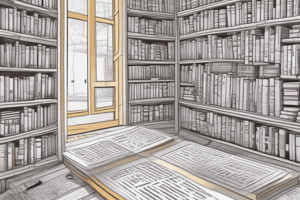Podcast
Questions and Answers
What rhetorical device does Bates use to emphasize the success of bats?
What rhetorical device does Bates use to emphasize the success of bats?
- Metaphor
- Alliteration
- Rhetorical question (correct)
- Simile
Bats were found to have an insignificant role in promoting plant health and diversity.
Bats were found to have an insignificant role in promoting plant health and diversity.
False (B)
What are the two ways bats contribute to the health of ecosystems?
What are the two ways bats contribute to the health of ecosystems?
Pollination and dispersal of plant species
The use of a colon in the essay serves to _____ the point made about bats promoting plant health.
The use of a colon in the essay serves to _____ the point made about bats promoting plant health.
Match the following elements with their descriptions:
Match the following elements with their descriptions:
What does the color blue typically signify?
What does the color blue typically signify?
A jagged line typically represents calmness and repose.
A jagged line typically represents calmness and repose.
What potential significance is associated with the color green?
What potential significance is associated with the color green?
A _____ line is often interpreted as representing loftiness and spirituality.
A _____ line is often interpreted as representing loftiness and spirituality.
Match the following colors with their potential significance:
Match the following colors with their potential significance:
What is the purpose of parallel structure in writing?
What is the purpose of parallel structure in writing?
Pronoun use reduces the clarity of a written piece.
Pronoun use reduces the clarity of a written piece.
What role do transitions play in writing?
What role do transitions play in writing?
Authors use ______ to create emphasis by asking questions that make a point.
Authors use ______ to create emphasis by asking questions that make a point.
Match the terms to their correct descriptions:
Match the terms to their correct descriptions:
Which of the following punctuation marks can emphasize a point?
Which of the following punctuation marks can emphasize a point?
Brief sentences can create a sense of urgency in writing.
Brief sentences can create a sense of urgency in writing.
What effect does repetition have on a thesis throughout a text?
What effect does repetition have on a thesis throughout a text?
Flashcards
Parallel Structure
Parallel Structure
Using the same grammatical structure to express multiple related ideas in a row.
Pronoun Use
Pronoun Use
Replacing nouns with pronouns to avoid repetition.
Repetition
Repetition
Repeating words or phrases to emphasize an idea or point.
Transitions
Transitions
Signup and view all the flashcards
Punctuation for Emphasis
Punctuation for Emphasis
Signup and view all the flashcards
Rhetorical Question
Rhetorical Question
Signup and view all the flashcards
Sentence Brevity/Fragments
Sentence Brevity/Fragments
Signup and view all the flashcards
Parallel Structure for Emphasis
Parallel Structure for Emphasis
Signup and view all the flashcards
Thesis Statement
Thesis Statement
Signup and view all the flashcards
Emphatic Punctuation
Emphatic Punctuation
Signup and view all the flashcards
Writing Style
Writing Style
Signup and view all the flashcards
Abstract Title
Abstract Title
Signup and view all the flashcards
Color symbolism in art
Color symbolism in art
Signup and view all the flashcards
Line symbolism in art
Line symbolism in art
Signup and view all the flashcards
Repetition in art
Repetition in art
Signup and view all the flashcards
Thick lines in art
Thick lines in art
Signup and view all the flashcards
Thin lines in art
Thin lines in art
Signup and view all the flashcards
Study Notes
Essay/Story Coherence
- Parallel structure in words allows readers to understand relationships between multiple ideas presented in sequence. These ideas must use similar phrasing styles for clarity.
- Pronoun use improves coherence by replacing proper nouns. This prevents repetitive nouns or proper nouns.
- Repetition of a word/phrase helps readers understand the development of the thesis (main idea). This only applies to words/phrases connected to the thesis.
- Transitions (words/phrases) guide readers from one concept to the next. They help anticipate how ideas connect. Emphatic transitions (e.g., "in addition") suggest elaboration. Oppositional transitions (e.g., "however") suggest opposing ideas.
Emphasis
- Parallel structure emphasizes ideas by using similar grammatical forms to present equal importance.
- Punctuation, like exclamation points, dashes, and quotation marks, can emphasize ideas.
- Repetition of key words/phrases can create emphasis.
- Rhetorical questions emphasize ideas because they invite consideration, but do not need answering.
- Brief sentences/fragments can be emphatic by being concise and conveying a sense of urgency.
Style (Formal/Informal)
- Informal style:
- First-person point of view (using "I," "we," etc.)
- Short sentences/fragments
- Short paragraphs
- Contractions
- Conversational vocabulary
- Rhetorical questions
- Figurative devices (imagery, etc.)
- Emotional tone
- Formal style:
- Third-person point of view
- Detailed sentences
- Longer paragraphs
- Few or no contractions
- Sophisticated vocabulary
- Few or no rhetorical questions
- Factual and well-documented tone
Visuals (Message)
- When expressing a visual message, use a thematic statement, avoid first- and second person pronouns, avoid imperatives, and avoid clichés.
- Express the message as a full thematic statement.
- Minimize use of first/second person pronouns.
- Avoid use of imperative statements.
- Avoid clichés.
- Avoid figurative language.
- Determine the significance of visual elements to support theme development.
Mood
- Color Significance:
- Red: energy, anger, evil, excitement, danger, joy, passion
- Pink: happiness, lightheartedness, youth, innocence, romance
- Orange: warmth, joy, positivity, action, unease, danger
- Yellow: energy, vibrancy, lightness, optimism
- Green: wealth, nature, sickness, poison, envy
- Blue: contemplation, harmony, tranquility, sadness, melancholy
- Violet: royalty, decadence, mysticism, passion
- Brown: earth, life, growth, decay
- Line Significance:
- Horizontal: calmness, rest
- Vertical: loftiness, stability
- Diagonal: movement, direction, tension
- Curved (shallow): comfort, safety, familiarity, tranquility
- Curved (deep): confusion, turbulence, tension, anxiety
- Jagged: movement, tension, anxiety
- Directional: emphasis
- Thick: emphasis
- Thin: softness
- Repeating: unity
Visual Elements
- Symbol
- Texture
- Angle
- Balance
- Color
- Focal Point
- Focus
- Frame
- Lighting
- Asymmetry
- Background
- Composition
- Contrast
- Foreground
- Juxtaposition
- Symmetry
Studying That Suits You
Use AI to generate personalized quizzes and flashcards to suit your learning preferences.




